The African fat tail gecko has brown and orange colors that are unique to this particular species. There are also African fat tail geckos that have red, green, yellow, tan or other combinations of colors on their skin. These variations are morphs that are the result of genetic alterations.
Below, we’ll explore the African fat tail gecko’s fascinating appearance as well the different morphs to choose from.
What is a gecko morph?
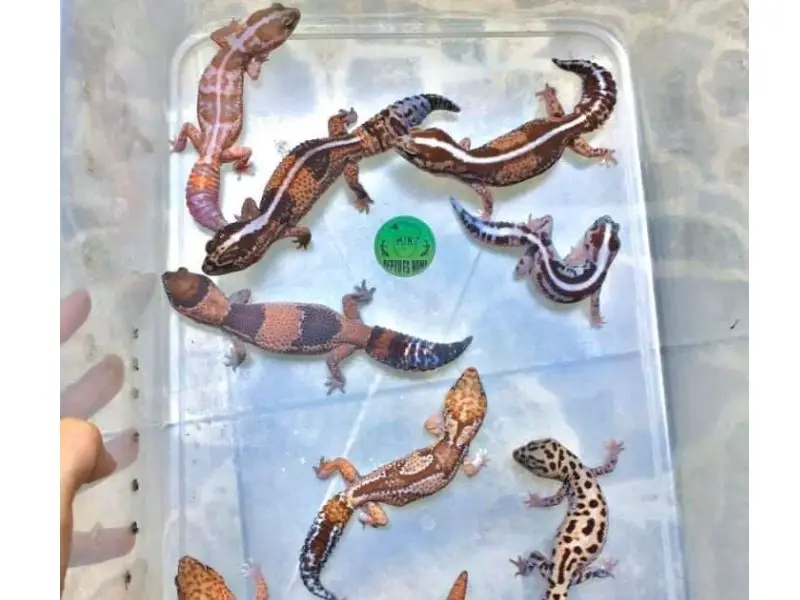
Gecko morphs are combinations of gecko species and genes. African fat tail gecko morphs are specially bred varieties that have different colors and patterns. These morphs are made by professional reptile breeders who try to create a particular color or pattern through genetic mutations.
There are very many color variations of the African fat tail gecko with the color patterns differing from one to the other.
The typical base morph of the African fat tail gecko has a round body with a fat tail – which is bigger than that of a leopard gecko.
The normal or base morph of the African fat tail gecko is the banded type. Basically it’s a brown-banded lizard with different shades of brown. The bands are sometimes a darker brown on top, so the gecko may be very plain-looking than other morphs you may have seen.
The color of the gecko varies from white to black on different parts of its body. In some variations, there’s usually a single whitish line running down the middle of the back, but there may be a few spots of black-brown in bands on the rest of the body.
From this base color, breeders have come up with various morphs with a few color variations.
Common African Fat Tail Gecko Morphs
To tell if a gecko is a morph, you first need to know the size and base colors of the reptile since it is from its genetics that other morphs or color and size variations are created.
Here are the most common leopard gecko morphs:
1. Oreo African Fat Tailed Gecko Morph
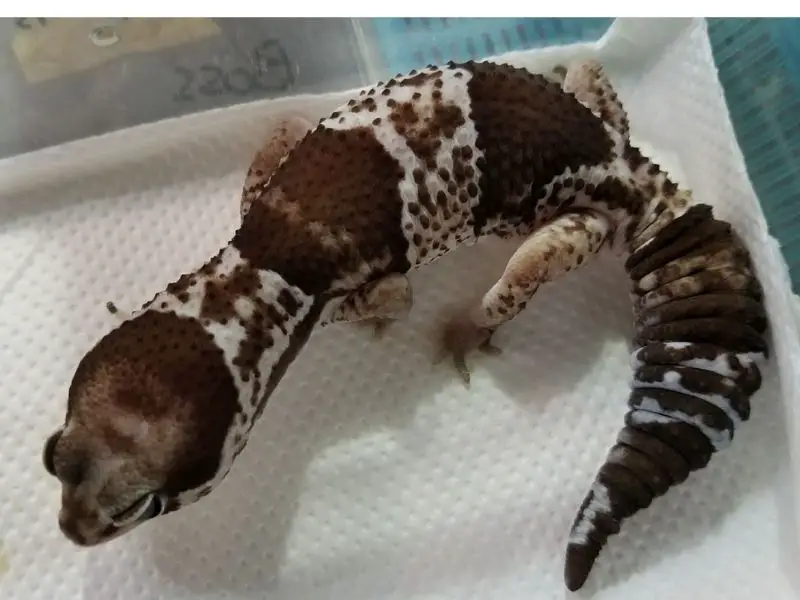
The oreo morph is the closest thing to the normal African fat-tailed gecko morph, only that the typical brown bands are way lighter they even almost look like a cream-colored morph.
The oreo morph has a recessive trait that takes away yellow or red pigmentation from the typical black-brown band. The Oreo African fat tailed gecko morph can be a combination of chocolate and vanilla colors. The body coloration starts with dark brown on the head, neck, spine and upper back then transitions to light tan down the lower back, tail and legs that fades out into white at the belly.
2. Whiteout oreo

When you put the oreo morph side to the white out oreo morph, you will see that the white out has a funky pattern. If the bands are not clean, they appear to be messy, which adds a little bit more white to the whiteout gecko.
Clearly, the white out is a codominant mutation, which means that you need one white out to produce visual witeouts when paired with a normal base morph of the African fat tailed gecko.
3. Striped whiteout

The striped whiteout African fat tailed gecko morph is the same as a Whiteout Oreo, but has stripes of dark brown or black running from head to tail. These stripes appear to spread on either side of the white line that appears to run from the head down to the tail.
Some breeders would call this African fat tailed gecko a striped normal because of the bands of dark brown on the body.
4. Zulu
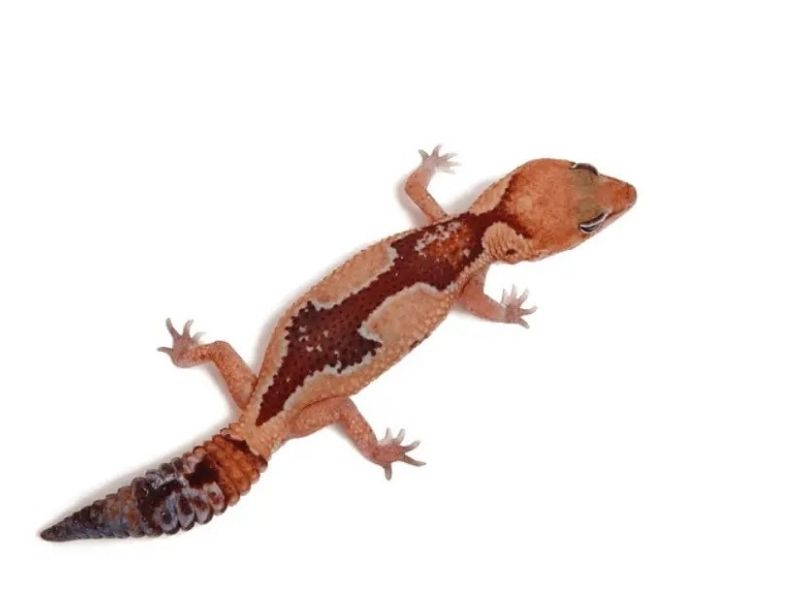
The Zulu African fat-tailed gecko has color patterns common to wild type except for the markings of the Zulu warriors. If you look at the back of the tail, you will notice that there are marks that resemble a two-sided spear.
In general, the Zulu African fat-tailed gecko morph is identical in coloration as wild type, but the zulu markings take a different type of shape as opposed to the common bands of the base morph.
This African gecko makes for a beautiful addition to any lizard collection.
5. Albino morph
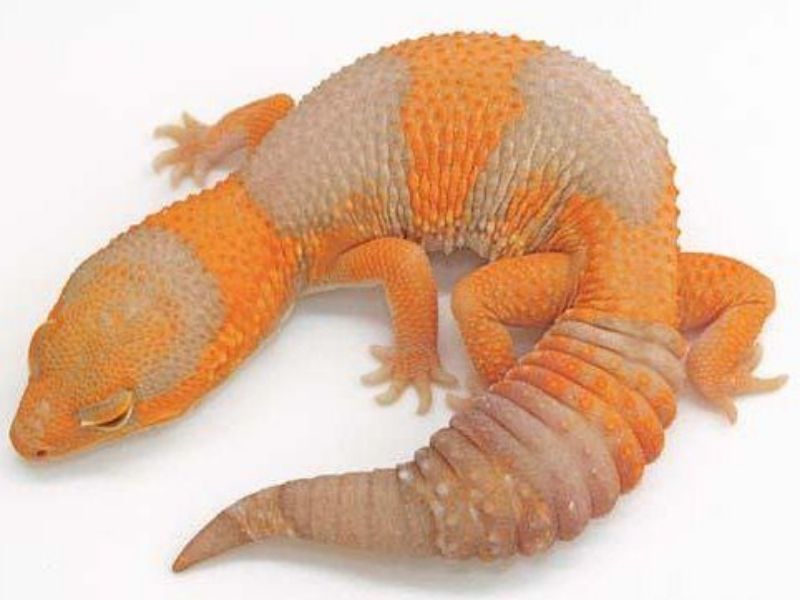
The albino morph is genetically recessive in the Albino African fat-tailed gecko morph. So, what does it look like? Albino African fat-tailed gecko morphs have a light pink to cream body with white eyes. Albino African fat-tailed geckos are born pure albino and may or may not darken over time, but the color will never change back to bright yellow.
This morph is an interesting one as it is recessive in nature which means that offspring from these reptiles would be of either the regular African Fat Tail Gecko Morph form (a “wild type”) or they might take on this unique Albino Morph appearance instead.
The Albino version does not carry any genetic information for its colorful markings so all the bands disappear into this creamy hue while the rest of the body retains its original Albino coloring.
It is interesting to note that Albino Fat-tailed geckos are not as active and tend to be a bit more shy than their wild type counterparts, so they will need plenty of hiding spots in order for them to feel safe enough around human handlers.
6. Striped albino
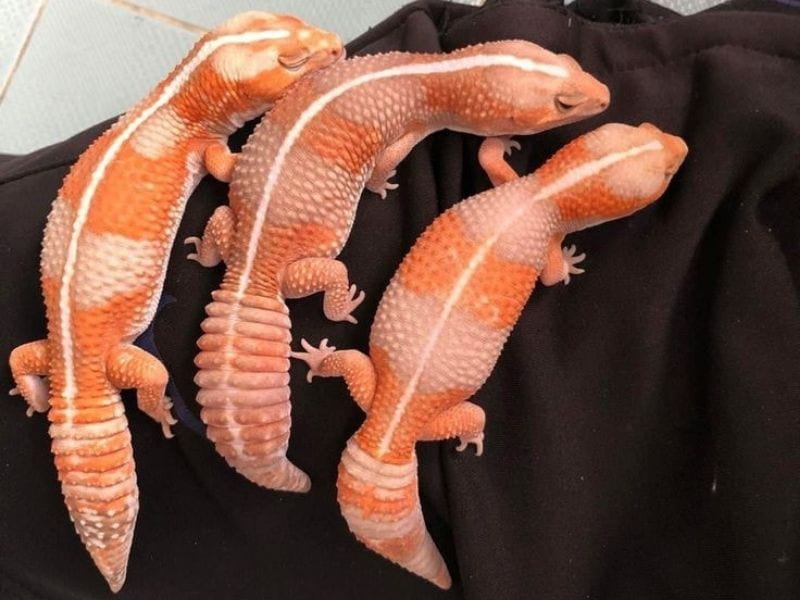
The striped albino morph is also called Amel. In terms of coloration, this gecko has the same bands as the base morph with the body appearing to have pale pink or cream with white or orange bands.
The Striped Albino Morph is very beautiful and can be quite striking in appearance when the animal matures and its colors become brighter. It also has an interesting personality – it tends to be more docile than wild type or other morphs which makes them easy for handling by humans but not so good if you live in a busy household full of children who want to pick them up all day long.
7. Stinger
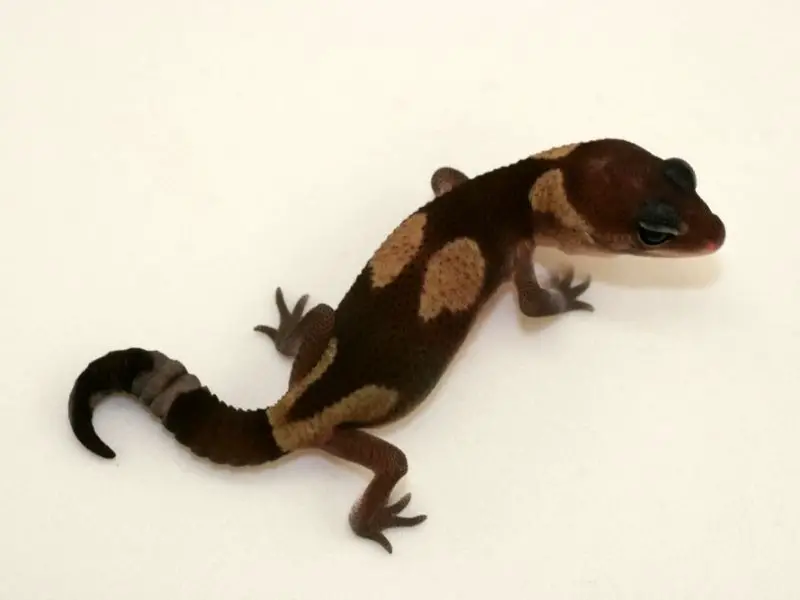
On the Stinger morph, the back bands are linked together. The bottom band comes to a tip that mimics the stinger of a bee. Patternless stinger morphs are unproven because they are a more recent morph that was formerly considered to be co-dominant with the super morph, which was a super stinger. The recessive nature of super stingers has subsequently been established.
The stinger is said to have a recessive gene that is used for breeding patternless morphs, or even the highly spotted African fat tail geckos that appear almost similar in color to leopard geckos.
8. Striped tangerine
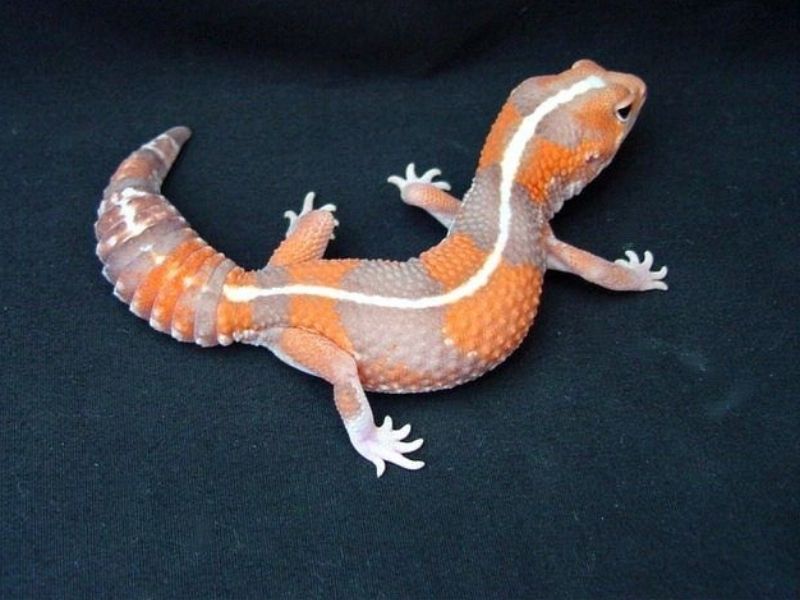
The Striped Tangerine African fat-tailed gecko morph has the typical orange hues that are almost similar to those of orange leopard gecko morphs. This variation of the striped albino morph has a more orangey color than its previous counterpart and can range in appearance from light to dark shades of tangerines with white or cream bands.
It’s not nearly as common as the other striped albinos but they are still fairly easy to find because many breeders like this coloration better due to how attractive it looks on adult geckos.
9. Ghost Patternless

The Ghost Patternless African fat-tailed gecko morph has an all white or greyish body with a single white line running from the head down to the tail. It looks like it’s wearing the old school “whitey tighties” with a single highly visible white line on its back.
The major differentiating trait with this morph is that it does not have the bands that are common with the other morphs – except for some albinos of course. The variation is not very common as it almost loses the signature banding that is known to be typical in African fat tails.
10. Whiteout ghost

The Whiteout Ghost African fat-tailed gecko morph is a variation in the banding pattern, where there are no bands of any color.
It can also look like an albino only that if you look closely, you’ll see the bands are there in faint gray or a color that closely resembles the rest of the body. The Whiteout Ghost does not have the distinctive markings that make other variations so distinctively identifiable. This may enable cross breeding with other morphs easier to introduce dominant genes that can produce other interesting morphs of the lizard.
This type appears to be gaining popularity among breeders as it’s easy to find because many prefer this coloration better due to how attractive it looks on adult geckos, and how easy it is to breed and come up with new morphs.
11. Granite
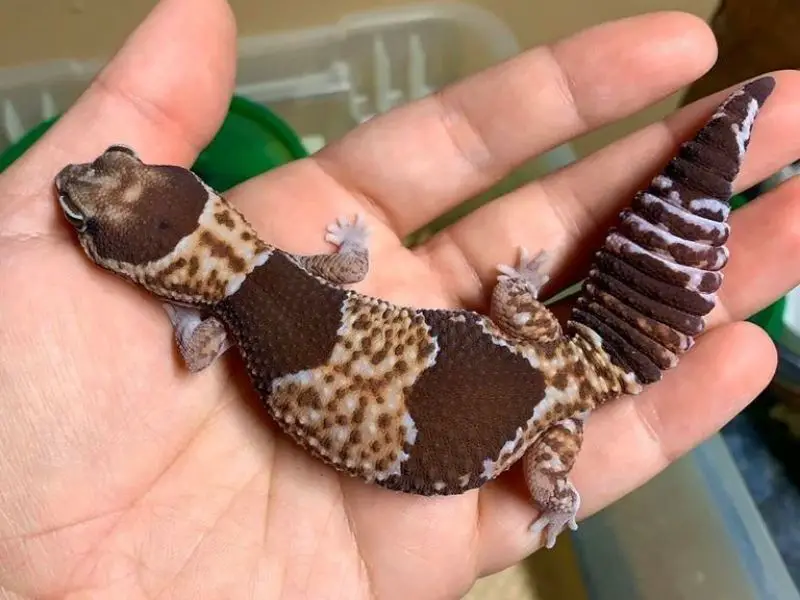
The granite morph of the African fat tailed gecko is also unique even though it looks very similar to the normal morph. The difference is that the dark brown bands on the body appear to have granite-like speckles, which give the gecko a very unique appearance.
Looking at the granite morph from afar, you can easily confuse the lizard for the wild type but when you get closer, you’ll notice the light brown or dark brown bands are not clean; they have some specks in them.
Another thing to note is that the granite morph does not have the common white stripe running down the middle of its upper body.
12. Jungle
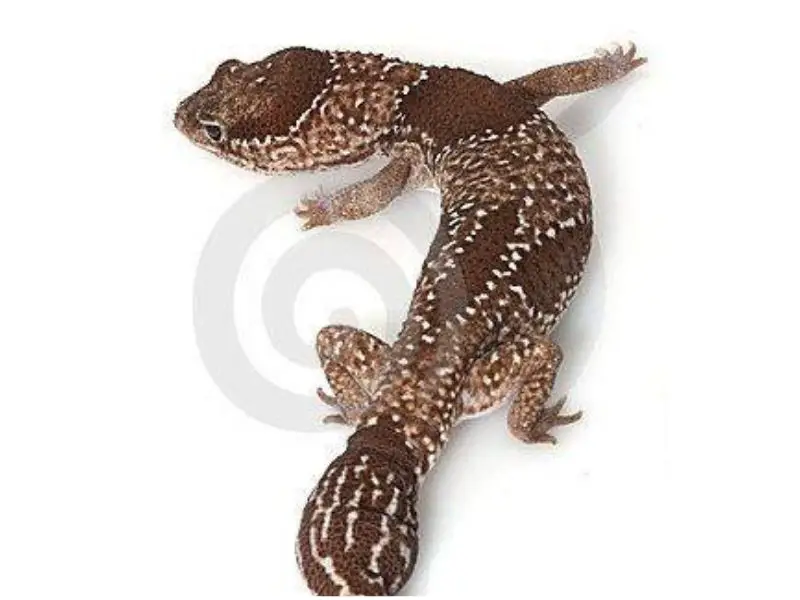
The Jungle morph is a variation of the wild type that was bred by crossing two different African fat-tailed geckos to create an offspring with a jungle appearance. The most obvious difference between this morph and the original one is in its coloration that is never really a definite patter, especially the spots that appear on the outer lines of the bands.
Unlike other variants, the jungle variant has whitish or blackish spots around the dark brown bands on its body, which makes it look quite unique.
13. Starburst

The starburst morph of the African fat-tailed gecko appears to have a blushed orange head with a narrow brown band with dark specks running around it at the eye-level.
The second most noticeable difference between starbursts and other morphs is the lack of a white stripe that commonly originates from the head and ending near the tail in other fat tail geckos.
Other Morphs of the African Fat-Tailed Gecko
Apart from the morphs I’ve listed above, you will commonly find some variations that are bred from mixing dominant and recessive genes. Some of them are simple white outs of the more bold colored morphs you will find in online pet shops.
Here are some common morphs to consider as well:
| Oreo Zulu | Whiteout zulu |
| Banded | Stripe |
| White Out Super Stinger | Zero |
| Caramel Albino | Caramel Oreo |
| White Out Caramel | White Out Oreo |
| White Out Super Zero | Exact Zero |
Whether you’re a breeder or just an enthusiast looking to buy a gecko pet, you might want to know a few terms to help you in choosing a morph that’s best suited for you.
Here are some of the terms used in gecko morphing:
Recessive gene
What does recessive gene mean? Recessive genes are traits that only show up when the reptile has two copies of the same gene. Recessive genes can be thought of as “hidden” characteristics, because they don’t always manifest in their phenotypic form.
You might not even know that your gecko carries these genes, but they might manifest later on in the breeding line of your African fat-tailed gecko.
Dominant gene
Dominant genes are the gecko traits that show up in their phenotypic form with just one copy of the dominant gene.
For example, if the gecko has a brown coloration as the dominant gene with the albino gene as the recessive one, then your geckos will always be born with the brown color because it only needs to inherit one dominant gene in order to show that dominant trait.
Gene mutations
Mutations are gene changes that don’t always happen and are only found in a small percentage of the geckos.
These gene mutations can lead to interesting color morphs, like with albino models. The gene mutation is brown instead of being white because it has its own dominant gene for coloring which overrides the recessive gene trait
Heterozygous
Heterozygous is a term that refers to either of two different alleles for the same gene. Heterozygous genes are dominant because more than one allele will be expressed, so it’s not possible to have an individual with only recessive traits.
The Het (heterozygote) gecko can express some of its color in spots or patches on their skin which would make them less likely to blend into the environment. It could also mean they have better vision since these colors create contrast rather than blending together like other animals that inhabit dark environments do.
Color pattern
Most breeders try to achieve a unique color pattern of their geckos, which is why the idea of morphs is important in the reptile pet business. Color pattern in morphing simply means breeding to change the color of the offspring using two different genetic makeups of the parents.
In most cases, color pattern is determined by two loci: one for white (the color), and a second that determines if it’s solid or spotted. These alleles are on different chromosomes so they segregate independently of each other, which means that when an animal has heterozygous genes for these traits, both will be expressed in various combinations over time.
Heterozygous genes end up being dominant because more than one allele will be expressed – unlike recessive traits where there would only be one expression per individual.

